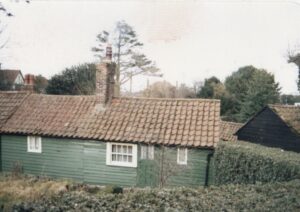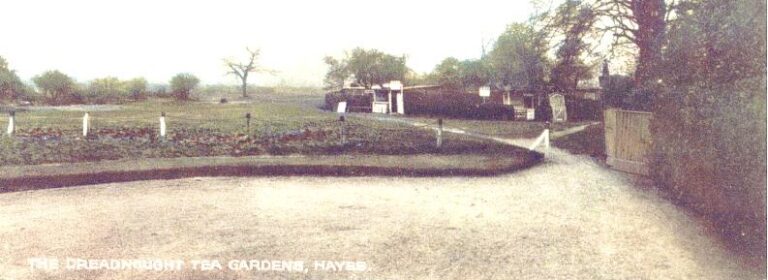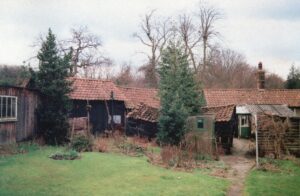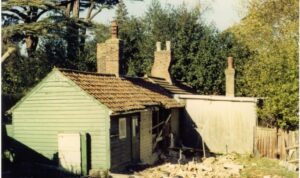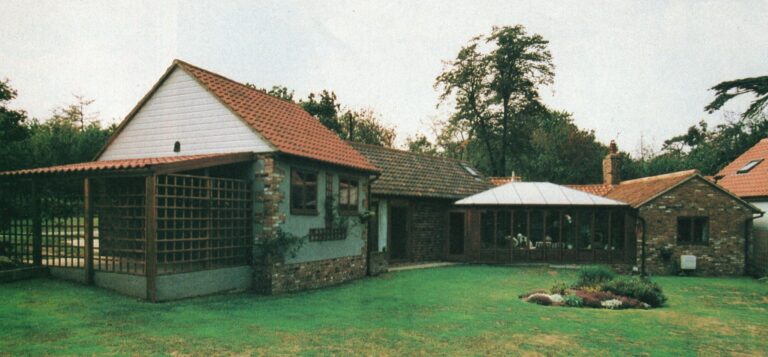Dreadnought Cottage, (Stacey’s Cottage)
Baston Road
Early 19th century
Locally listed
Stacey’s
Dreadnought Cottage was originally part of Winch’s Cottage which in the mid 19th century became known as Stacey’s after George and Ann Stacey and their eight children, aged from 5 months to 13 years in the 1841 Census, moved into the southern end of the property to look after Anne’s mother, Elizabeth Winch. A lightweight partition was fixed between the two halves of the cottage. When Elizabeth died in 1850 she left George and Anne all the property in her will. Anne’s brother James disagreed, claimed he had a right to it and he occupied part of the cottage. The matter went to court and eventually through the arbitration of the rector, Revd Thomas Hussey, the boundaries were fixed between the two cottages in 1853.
George, a vermin destroyer, and his wife Anne were allowed to remain in that part of the property in which they had lived with their family. James was allowed the part that had been occupied by his mother. When Elizabeth died Sir Charles Farnaby agreed that George and Anne Stacey could purchase their cottage for £11. Two of their sons, Richard & William, also became rat catchers.
In 1867, after their mother Anne’s death, the other siblings who had an interest in the property agreed to convey the premises to the eldest son Richard, providing that their father George was allowed to live in the cottage and be fully supported by Richard until his father’s death, which occurred in 1870. The property was lived in by successive generations of the Stacey family until the Second World War.
In 1910 it was described as a very old timber and tile bungalow, containing two bedrooms, kitchen, washroom and WC. Outside was a range of very old brick and tile buildings, sheds and WC washroom. On the opposite side of the road was a cowshed and two dilapidated sheds. Its value was put at £200.
A Smuggler’s Hiding Place
George Smith, a builder, remembered Richard Stacey junior, with his ferret bags and pack of terriers at his heel – a fine specimen of a Kentish-man. He also recalled in 1924 that some years ago when they were making additions to the cottage they came upon a smuggler’s hiding place under the floor with iron hooks upon which to hang the booty of spirit or silk. Richard Stacey said that it was in the neighbouring cottage.
Tea Garden
At the end of the First World War Richard Stacey decided to run a tea garden known as the Dreadnought Tea Gardens. It was very popular with local cycling and hiking groups. He continued to run this until his death in 1938. His widow Mercy died in 1942.
Second World War
World War II saw considerable activity over the Common and frequent incendiaries and bombs which left their mark on nearby areas. In a heavy bombardment on 16 April 1941 a number of high explosive bombs fell near Dreadnought Cottage. Eric Strouts, a stretcher bearer and fire watcher, who lived in Redgate Drive, was killed fighting the fires.
After the War
After the war the family decided to rent out the cottage as a furnished property and they secured planning agreement for a garage, providing a large shed was taken down and all the ‘temporary’ buildings opposite were demolished.
For many years it was rented by Leslie McCrow
Redevelopment
In 1985 it was bought by a builder Mr Brace and considerable ingenuity was used to make it a modern dwelling for his son, incorporating the footprint of the numerous outbuildings.
When completed the property consisted of a lounge, dining room, kitchen/breakfast room, a conservatory, 3 bedrooms and an outside garage. The development was praised and reported fully in the magazine Finesse in 1999. There have been two more owners since that time.

